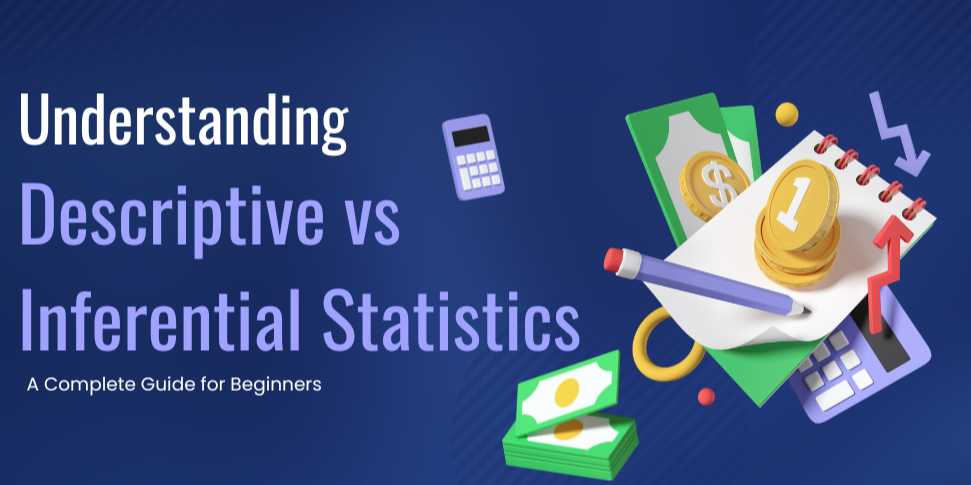Understanding Descriptive vs Inferential Statistics: A Complete Guide for Beginners

📗 Chapter 5: Practical Applications and Tools
Apply Statistics to Real-World Problems Using Python,
Excel, and Visualization Libraries
🧠 Introduction
Up to this point, you’ve learned the theory behind descriptive
and inferential statistics. Now it’s time to put those concepts into
action using real-world tools and use cases.
In this chapter, we’ll explore how statistics power
decisions in business, healthcare, science, and tech — and how you can use
tools like Python, Excel, and visualization libraries to
bring your insights to life.
You’ll learn:
- How
to structure and analyze data with descriptive and inferential statistics
- Tools
used by analysts and data scientists
- Project
examples with code samples
- Practical
workflows using Python, Excel, and BI dashboards
📘 Section 1: Practical
Scenarios for Statistical Analysis
|
Industry |
Descriptive Use
Case |
Inferential Use
Case |
|
Healthcare |
Average patient wait
time |
Compare survival rates
between two drugs |
|
Marketing |
Summarize
campaign CTR |
A/B test ad
creatives |
|
Education |
Class test score
summaries |
Predict graduation
rates |
|
HR & People Ops |
Track average
working hours |
Test if
training improves performance |
|
Finance |
Report quarterly
revenue |
Forecast next quarter
using past data |
📘 Section 2: Tools for
Statistical Analysis
|
Tool |
Best For |
Example Use |
|
Excel |
Beginners, quick
analysis, small datasets |
Budget reports, pivot
tables, bar charts |
|
Python |
Intermediate
to advanced analytics |
Machine learning,
large-scale inference |
|
R Language |
Academic or
statistical modeling |
Hypothesis testing,
advanced visualization |
|
SPSS/SAS |
Clinical
trials, survey analysis |
Government
and pharma research |
|
Power BI / Tableau |
Dashboards &
storytelling |
Business performance
reports |
📘 Section 3: Using Excel
for Descriptive & Inferential Stats
Descriptive in Excel:
|
Function |
Description |
|
=AVERAGE(range) |
Mean |
|
=MEDIAN(range) |
Median |
|
=MODE.SNGL(range) |
Mode |
|
=STDEV.P(range) |
Standard
Deviation |
Inferential in Excel (with Data Analysis ToolPak):
- Enable
Data Analysis Toolpak
- Go
to Data > Data Analysis > t-Test, ANOVA, Correlation
📌 Example: T-Test in
Excel
Compare mean satisfaction scores between two branches.
|
Branch A |
Branch B |
|
4.1 |
4.8 |
|
4.3 |
4.5 |
|
4.0 |
4.6 |
Use t-Test: Two-Sample Assuming Unequal Variances in
Data Analysis ToolPak.
📘 Section 4: Using Python
for Applied Statistics
📌 Dataset: Titanic
python
import
pandas as pd
df
= pd.read_csv("https://raw.githubusercontent.com/datasciencedojo/datasets/master/titanic.csv")
Descriptive Summary:
python
df.describe()
df['Age'].mean(),
df['Age'].median(), df['Age'].mode()[0]
Inferential Analysis: Survival vs. Gender
python
import
scipy.stats as stats
female
= df[df['Sex'] == 'female']['Survived']
male
= df[df['Sex'] == 'male']['Survived']
t_stat,
p_val = stats.ttest_ind(female, male)
print("t-statistic:",
t_stat, "p-value:", p_val)
📊 Interpretation:
If p < 0.05 → Survival rate difference between genders is
statistically significant.
Visualization with Seaborn:
python
import
seaborn as sns
import
matplotlib.pyplot as plt
sns.boxplot(x='Sex',
y='Age', data=df)
plt.title("Age
Distribution by Gender")
plt.show()
📘 Section 5: BI Dashboard
Integration (Power BI/Tableau)
- Import
data from Excel or CSV
- Use calculated
fields to show mean, median, or percent change
- Visualize
trends with line charts, bar plots, filters
- Create
interactive dashboards for decision makers
📘 Section 6: Case Study –
A/B Testing a Website Feature
🧪 Problem:
Does showing a product video increase conversion rates?
- Group
A: Sees only text
- Group
B: Sees video + text
python
group_A
= [12, 15, 14, 13, 12] # conversions out
of 100 visitors
group_B
= [18, 20, 19, 21, 22]
from
scipy.stats import ttest_ind
t_stat,
p_val = ttest_ind(group_B, group_A)
print("p-value:",
p_val)
If
p_val < 0.05: Evidence that video improved conversions.
📘 Section 7: Statistical
Workflow in Python
✅ A typical statistical analysis
pipeline:
python
#
1. Import and clean data
df
= pd.read_csv('data.csv')
df.dropna(inplace=True)
#
2. Descriptive overview
print(df.describe())
sns.histplot(df['Revenue'])
#
3. Hypothesis test
from
scipy.stats import ttest_1samp
t_stat,
p_val = ttest_1samp(df['Revenue'], 10000)
#
4. Result interpretation
if
p_val < 0.05:
print("Revenue significantly differs
from $10,000")
📘 Section 8: Best
Practices
|
Tip |
Why It Matters |
|
Always visualize
your data |
Charts reveal patterns
stats may miss |
|
Understand your sampling method |
Garbage in,
garbage out |
|
Check assumptions
before testing |
Tests have rules
(normality, independence) |
|
Combine stats with business context |
Data alone
isn’t enough — context is key |
|
Automate with
scripts or dashboards |
Save time and improve
repeatability |
📋 Summary Table: Tools
& Tasks
|
Task |
Excel |
Python |
BI Tool |
|
Mean, Median, Mode |
✅ |
✅ |
✅ |
|
t-Test / ANOVA |
✅
(ToolPak) |
✅
(SciPy, Statsmodels) |
❌
(limited) |
|
Correlation |
✅ |
✅ |
✅ |
|
Regression |
✅
(Analysis ToolPak) |
✅
(Sklearn) |
✅ |
|
Interactive
Dashboards |
❌ |
✅ (Plotly, Streamlit) |
✅ (Power BI, Tableau) |
FAQs
1. What is the main difference between descriptive and inferential statistics?
Answer: Descriptive statistics summarize and describe the features of a dataset (like averages and charts), while inferential statistics use a sample to draw conclusions or make predictions about a larger population.
2. Do I need both descriptive and inferential statistics in a data analysis project?
Answer: Yes, typically. Descriptive stats help explore and understand the data, and inferential stats help make decisions or predictions based on that data.
3. Can I use descriptive statistics on a population?
Answer: Absolutely. Descriptive statistics can be used on either a full population or a sample — they simply describe the data you have.
4. Why do we use inferential statistics instead of just analyzing the whole population?
Answer: It’s often impractical, costly, or impossible to collect data on an entire population. Inferential statistics allow us to make reasonable estimates or test hypotheses using smaller samples.
5. What are examples of descriptive statistics?
Answer: Common examples include the mean, median, mode, range, standard deviation, histograms, and pie charts — all of which describe the shape and spread of the data.
6. What are common inferential statistical methods?
Answer: These include confidence intervals, hypothesis testing (e.g., t-tests, chi-square tests), ANOVA, and regression analysis.
7. Is a confidence interval descriptive or inferential?
Answer: A confidence interval is an inferential statistic because it estimates a population parameter based on a sample.
8. Are p-values part of descriptive or inferential statistics?
Answer: P-values are part of inferential statistics. They are used in hypothesis testing to assess the evidence against a null hypothesis.
9. How do I know when to stop with descriptive statistics and move to inferential?
Answer: Once you've summarized your data and understand its structure, you'll move to inferential statistics if your goal is to generalize, compare groups, or test relationships beyond your dataset.
10. Can visualizations be used in inferential statistics?
Answer: Yes — while charts are often associated with descriptive stats, inferential techniques can also be visualized (e.g., confidence interval plots, regression lines, distribution curves from hypothesis tests).
Tutorials are for educational purposes only, with no guarantees of comprehensiveness or error-free content; TuteeHUB disclaims liability for outcomes from reliance on the materials, recommending verification with official sources for critical applications.
Explore Other Libraries
Please allow ads on our site
Kindly log in to use this feature. We’ll take you to the login page automatically.
Login
Join Our Community Today
Ready to take your education and career to the next level? Register today and join our growing community of learners and professionals.

Your experience on this site will be improved by allowing cookies. Read Cookie Policy
Your experience on this site will be improved by allowing cookies. Read Cookie Policy

Comments(0)